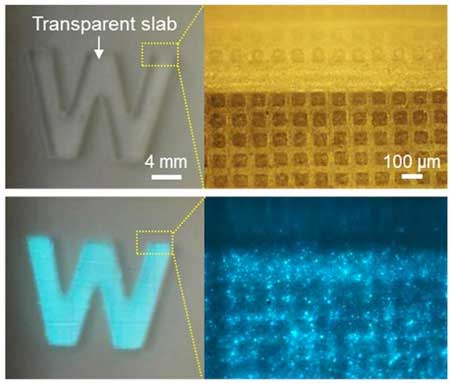| Posted: Nov 01, 2017 |
Jellyfish-inspired electronic skin glows when it gets hurt
(Nanowerk News) Electronic-skin technologies for prosthetics and robots can detect the slightest touch or breeze. But oddly, the sensors that make this possible do not respond effectively to a harmful blow.
|
|
Now researchers report in ACS Applied Materials & Interfaces ("Dual-Mode Electronic Skin with Integrated Tactile Sensing and Visualized Injury Warning") the development of a jellyfish-inspired electronic skin that glows when the pressure against it is high enough to potentially cause an injury.
|
 |
| An electronic skin glows when a transparent 'W' is pressed onto it, and a voltage is applied (bottom). (© American Chemical Society)
|
|
An electronic skin that can mimic the full range of biological skin's sensitivity has great potential to transform prosthetics and robotics. Current technologies are very sensitive, but only within a narrow range of weak pressures. Under high pressures that could cause damage, the electronic skins' sensitivity fades.
|
|
To address this shortcoming, Bin Hu and colleagues at the Huazhong University of Science and Technology turned to the Atolla jellyfish for inspiration. This bioluminescent, deep-sea creature can feel changes in environmental pressure and flashes dramatically when it senses danger.
|
|
Building on the idea of a visual warning in response to a physical threat, the researchers combined electric and optical systems in a novel electronic skin to detect both slight and high-force pressures. They embedded two layers of stretchy, poly-dimethysiloxane, or PDMS, film with silver nanowires. These layers produce an electrical signal in response to slight pressures, such as those created by a breeze or contact with a leaf. Sandwiched in between the silver nanowire electrodes is a PDMS layer embedded with phosphors. This layer kicks in and glows with growing intensity as the physical force increases.
|
|
The researchers say this approach more closely copies the wide range of pressures the human skin can feel.
|

